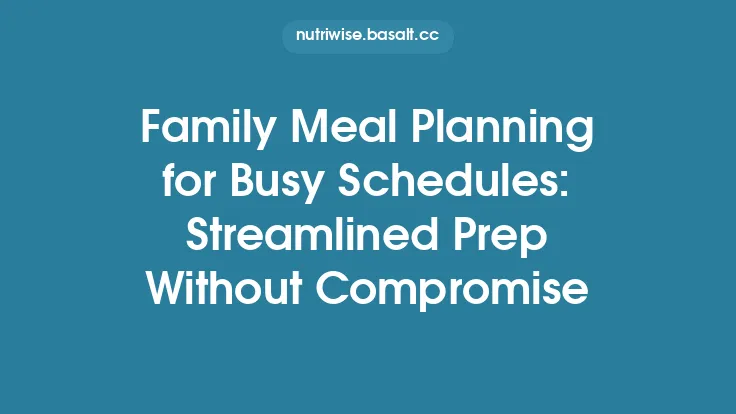Pasta has long been the go‑to comfort food for busy households, but the traditional method—boiling water, cooking the noodles, draining, then tossing with sauce—can feel like a time sink when you’re racing against the clock. One‑pot pasta flips the script: the noodles, sauce, aromatics, and even protein or vegetables all share the same pot, allowing flavors to meld while you dramatically cut down on both cooking time and cleanup. When executed correctly, a satisfying, restaurant‑quality pasta dish can be on the table in under 25 minutes, making it an ideal centerpiece for quick‑and‑easy meal planning.
Below, we’ll explore the science behind one‑pot pasta, essential pantry staples, step‑by‑step techniques, and a suite of versatile variations that keep the menu fresh without sacrificing speed. Whether you’re feeding a family of four, prepping meals for the workweek, or looking for a solo dinner that won’t leave a mountain of dishes, these strategies will help you master the art of rapid, one‑pot pasta.
The Science of One‑Pot Cooking
Starch Release and Sauce Thickening
When pasta cooks, it releases starch into the surrounding liquid. In a traditional two‑pot method, this starch‑laden water is often discarded, but in a one‑pot system it becomes a natural thickener for the sauce. By controlling the amount of liquid you start with, you can dictate the final sauce consistency: less liquid yields a creamier, clingier coating, while a bit more produces a soupy, broth‑like dish.
Heat Transfer and Uniform Cooking
Using a single, heavy‑bottomed pot (such as a Dutch oven or a deep sauté pan) ensures even heat distribution. This prevents the bottom layer of noodles from scorching while the top remains undercooked. A lid placed on the pot for the first few minutes traps steam, raising the internal temperature and accelerating the pasta’s hydration.
Flavor Integration
Because the aromatics, herbs, and any added protein or vegetables share the same cooking environment, their flavors infuse the pasta directly. This eliminates the need for a separate sauté step and reduces the number of ingredients you have to juggle.
Core Ingredients You’ll Need
| Category | Typical Items | Why They Matter |
|---|---|---|
| Pasta | Spaghetti, linguine, penne, fusilli, or short shapes like ditalini | Long strands coat well with sauce; short shapes trap bits of vegetables and protein. |
| Liquid Base | Water, low‑sodium broth, canned tomatoes (whole, crushed, or diced), coconut milk, or a combination | Provides the cooking medium and contributes to the sauce’s flavor profile. |
| Aromatics | Olive oil, garlic, shallots, onion, ginger (optional) | Build depth; sautéed briefly before adding liquid to release essential oils. |
| Acidic Component | Red wine, white wine, balsamic vinegar, lemon juice, or a splash of tomato paste | Balances richness, brightens the dish, and helps break down proteins. |
| Seasonings | Salt, freshly cracked black pepper, dried herbs (oregano, basil, thyme), red‑pepper flakes | Essential for flavor; add at different stages for layered seasoning. |
| Optional Add‑Ins | Canned beans, frozen peas, spinach, sliced mushrooms, pre‑cooked sausage, canned tuna, shredded cheese | Provide protein, veg, and texture without extending cooking time. |
All of these items are pantry‑friendly and have a long shelf life, making the recipe truly “quick‑and‑easy” even when you’re low on fresh produce.
Step‑by‑Step Methodology
- Prep the Aromatics
- Mince 2–3 garlic cloves and finely dice half an onion (or a shallot).
- Heat 1–2 Tbsp of olive oil in a 4‑quart pot over medium heat. Add aromatics and sauté for 30–45 seconds until fragrant, being careful not to brown them.
- Deglaze and Add Liquid
- If using wine, pour in ¼ cup and let it reduce for 30 seconds.
- Add the primary liquid (e.g., 2 cups of low‑sodium broth) and any canned tomatoes. Stir to combine, scraping up any bits stuck to the pot.
- Introduce Pasta and Seasonings
- Add the dry pasta directly into the pot.
- Sprinkle in salt (about ½ tsp, adjusting for broth sodium), pepper, and dried herbs.
- If you like a little heat, add a pinch of red‑pepper flakes.
- Simmer with a Lid
- Bring the mixture to a gentle boil, then reduce to a simmer.
- Cover the pot loosely (a vented lid works best) and cook for 8–12 minutes, stirring every 2–3 minutes to prevent sticking. The exact time depends on pasta shape; check the package for “al dente” guidance.
- Add Quick‑Cook Extras
- In the final 2–3 minutes, stir in any fast‑cooking vegetables (e.g., frozen peas, spinach) or pre‑cooked proteins (e.g., sliced cooked chicken, canned tuna).
- If you want a creamy finish, swirl in a splash of coconut milk or a tablespoon of cream at this stage.
- Finish the Sauce
- Once the pasta is tender and the liquid has thickened to a sauce‑like consistency, remove the pot from heat.
- Finish with a drizzle of high‑quality olive oil, a squeeze of lemon juice, and a handful of grated Parmesan or Pecorino if desired.
- Rest and Serve
- Let the dish sit, covered, for 1–2 minutes. This allows the starches to settle and the sauce to fully coat the noodles.
- Serve immediately, garnished with fresh herbs (basil, parsley) or a sprinkle of cheese.
Time‑Saving Hacks
| Hack | How It Cuts Minutes |
|---|---|
| Pre‑measure Ingredients | Having broth, spices, and aromatics ready in small bowls eliminates on‑the‑fly measuring. |
| Use a Wide, Shallow Pot | Increases surface area, allowing liquid to evaporate faster and sauce to thicken quicker. |
| Opt for Thin Pasta Shapes | Thin strands like angel hair or capellini cook in 4–6 minutes, shaving off overall time. |
| Leverage Frozen Veg | No need to wash, chop, or pre‑cook; they go straight into the pot. |
| Batch Cook Broth | Keep a stock of homemade or store‑bought broth in the freezer; thaw in the microwave for instant use. |
| One‑Touch Seasoning | Use a pre‑mixed Italian seasoning blend to avoid measuring multiple herbs. |
Nutritional Considerations
One‑pot pasta can be nutritionally balanced with a few mindful tweaks:
- Whole‑Grain or Legume Pasta: Swap refined wheat pasta for whole‑wheat, chickpea, or lentil varieties to boost fiber and protein.
- Vegetable Boost: Incorporate at least one cup of vegetables per serving. Even quick‑cook options like frozen spinach or diced zucchini add micronutrients without extra prep.
- Lean Protein: Add canned beans, cooked turkey sausage, or shredded rotisserie chicken for a protein punch while keeping saturated fat low.
- Healthy Fats: Finish with a teaspoon of extra‑virgin olive oil or a handful of toasted nuts for monounsaturated fats and a pleasant mouthfeel.
A typical one‑pot pasta serving (≈1 cup cooked pasta, ½ cup sauce, ¼ cup veggies, 2 Tbsp protein) can provide roughly 350–450 kcal, 12–18 g protein, 8–12 g fiber, and a balanced mix of carbs and fats—ideal for a main meal or a post‑workout refuel.
Meal‑Planning Strategies
- Batch Cook for the Week
- Double the recipe and store half in airtight containers in the refrigerator for up to 4 days. Reheat in a microwave or on the stovetop with a splash of broth to revive the sauce.
- Freezer‑Friendly Variations
- Cool the cooked pasta and sauce completely, then portion into freezer‑safe bags. Freeze for up to 3 months. Thaw overnight in the fridge and finish with a quick sauté of fresh greens before serving.
- Build‑Your‑Own “Pasta Bar”
- Prepare a base one‑pot tomato‑broth pasta, then keep a selection of toppings (grilled vegetables, shredded cheese, chopped herbs, cooked protein) on the side. Family members can customize their bowls, reducing decision fatigue.
- Portion Control with Mason Jars
- Layer cooked pasta, sauce, and toppings in a 16‑oz mason jar. When ready to eat, simply shake, microwave for 2 minutes, and enjoy a portable, mess‑free meal.
Flavor Profiles to Explore
| Theme | Core Liquid | Key Add‑Ins | Signature Finish |
|---|---|---|---|
| Mediterranean | Crushed tomatoes + a splash of red wine | Kalamata olives, artichoke hearts, sun‑dried tomatoes | Fresh basil, feta crumble |
| Spicy Arrabbiata | Tomato sauce + a pinch of cayenne | Sliced chorizo or spicy Italian sausage | Red‑pepper flakes, parsley |
| Creamy Garlic‑Parmesan | Low‑fat milk + a dollop of cream cheese | Sautéed mushrooms, frozen peas | Grated Parmesan, cracked black pepper |
| Lemon‑Herb | Chicken broth + lemon zest | Asparagus tips, capers | Lemon juice, fresh dill |
| Asian‑Inspired | Low‑sodium soy sauce + broth | Shredded carrots, edamame, sliced shiitake | Sesame oil, scallions, toasted sesame seeds |
Each profile follows the same base method, allowing you to pivot flavors with minimal extra effort.
Common Pitfalls and How to Avoid Them
- Pasta Sticking to the Bottom
*Solution*: Stir frequently during the first 5 minutes and ensure there’s enough liquid at the start. A heavy‑bottomed pot distributes heat evenly.
- Sauce Too Watery
*Solution*: Use less initial liquid or let the dish simmer uncovered for the last 2–3 minutes to evaporate excess moisture. Adding a teaspoon of tomato paste can also thicken quickly.
- Over‑cooked Vegetables
*Solution*: Add quick‑cook veggies (spinach, peas) in the final minutes. For firmer vegetables (broccoli, carrots), pre‑steam or use frozen pieces that have already been blanched.
- Undersalted Pasta
*Solution*: Remember that the broth and canned tomatoes already contain sodium. Taste the liquid before adding extra salt; adjust gradually.
- Uneven Cooking of Protein
*Solution*: Use pre‑cooked or canned proteins that only need reheating. If you prefer raw sausage or chicken, brown it briefly before adding the liquid, then let it finish cooking with the pasta.
Equipment Recommendations
- Ideal Pot: A 4‑quart (or larger) heavy‑bottomed Dutch oven, enameled cast iron, or a deep sauté pan with a tight‑fitting lid.
- Stirring Tool: A sturdy wooden spoon or silicone spatula that can scrape the bottom without scratching the surface.
- Measuring Cups: For quick liquid ratios (typically 2 parts liquid to 1 part pasta by volume, but adjust based on pasta shape).
- Timer: Set for the pasta’s recommended cooking time; check at the halfway point to stir and assess liquid levels.
Sample Recipes (All Under 25 Minutes)
1. Classic Tomato‑Basil One‑Pot Spaghetti
- Liquid: 2 cups low‑sodium vegetable broth + 1 cup canned crushed tomatoes
- Add‑Ins: 2 cloves garlic, ½ tsp dried oregano, ¼ tsp red‑pepper flakes, 8 oz spaghetti (broken in half)
- Finish: 2 Tbsp fresh basil, ¼ cup grated Parmesan, drizzle of olive oil
2. Creamy Spinach & Mushroom Penne
- Liquid: 1 ½ cups chicken broth + ½ cup unsweetened almond milk
- Add‑Ins: 1 cup sliced mushrooms, 2 cups fresh spinach, 2 cloves minced garlic, ½ tsp thyme
- Finish: ¼ cup shredded mozzarella, a pinch of nutmeg
3. Lemon‑Garlic Shrimp Linguine
- Liquid: 1 ¾ cups seafood broth (or water + fish sauce) + zest of 1 lemon
- Add‑Ins: 8 oz linguine, ½ lb peeled shrimp, 2 Tbsp minced garlic, ¼ tsp crushed red pepper
- Finish: 2 Tbsp chopped parsley, squeeze of lemon juice, drizzle of extra‑virgin olive oil
4. Spicy Sausage & Chickpea Fusilli
- Liquid: 2 cups low‑sodium chicken broth + ½ cup canned diced tomatoes
- Add‑Ins: ½ cup canned chickpeas (rinsed), ¼ lb sliced spicy Italian sausage, 1 tsp smoked paprika, 1 clove garlic
- Finish: ¼ cup grated Pecorino, fresh cilantro
Each of these recipes follows the core method, ensuring you can execute them confidently without needing specialized techniques.
Final Thoughts
One‑pot pasta is more than a shortcut; it’s a versatile framework that lets you blend flavors, nutrients, and textures in a single vessel while keeping prep and cleanup to a minimum. By mastering the balance of liquid, starch, and timing, you can reliably produce dishes that feel both indulgent and wholesome in under 25 minutes. Keep a well‑stocked pantry, choose the right pot, and experiment with the flavor profiles outlined above—your weekly meal plan will thank you for the speed, simplicity, and delicious results. Happy cooking!





